Business
Palm, soybean oil markets moved higher last week
Despite a weaker Canadian dollar last week, the canola market managed to pull itself up and trade higher.
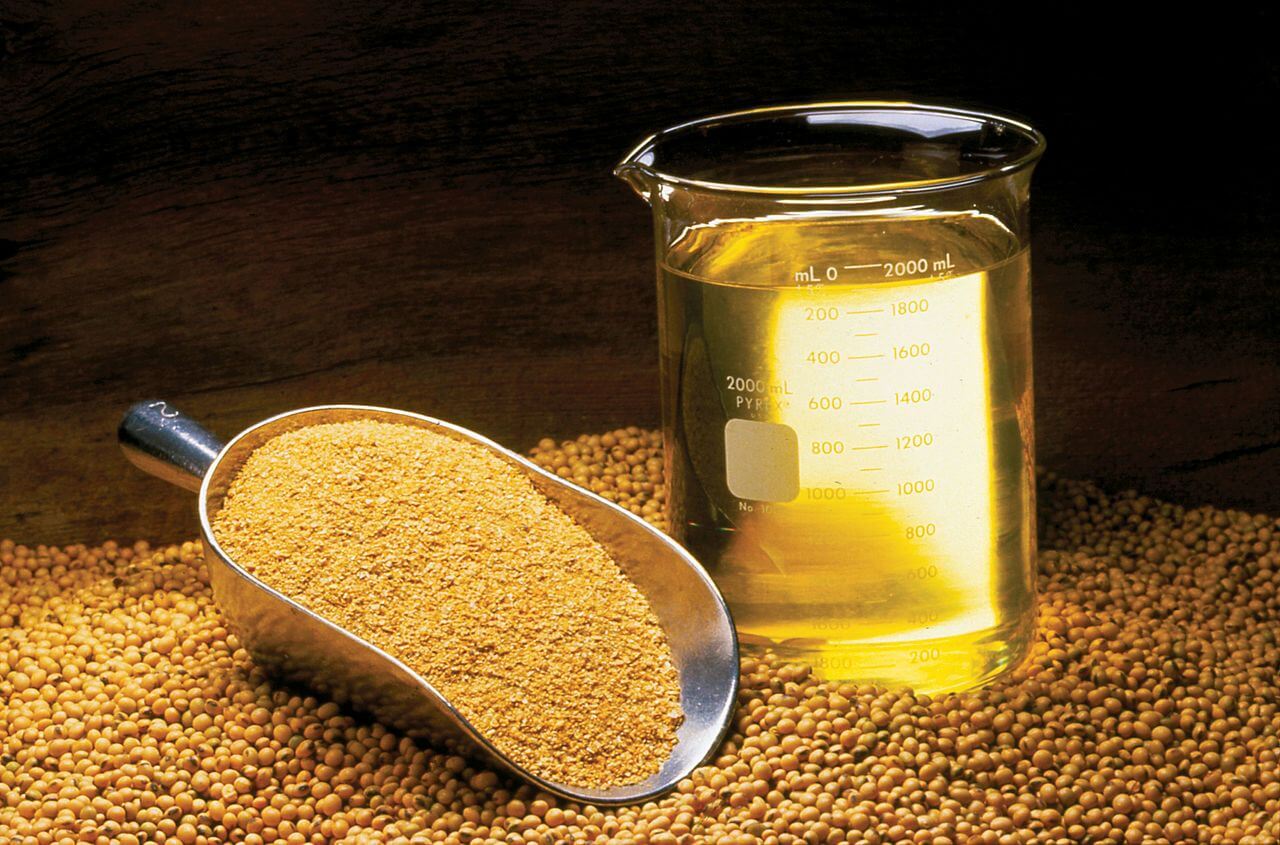
The markets of palm oil, soybean oil and canola had a good week as these three experienced increases. The palm oil market received some boost with the help of strong outcomes concerning its export earlier this month.
Wheat
US markets were lower last week in all three markets. The trade remains concerned about demand even though the weekly export sales report was strong last week. Export demand appears to be in line with USDA projections for the year. Traders do not appear all that concerned with the slower than normal planting progress for crops in the Great Plains and Midwest as there is plenty of Wheat available around the world. The US looks to plant fewer acres to wheat again this year, meaning that the US will have less area planted to wheat than seen over the last 100 or more years once again this year. The weekly charts show that futures moved close to some support areas again last week.
Australia has started to see some rains that have started to break the extreme drought seen in wheat country. However, it is close to harvest time now, so the rains might not be all that beneficial as big rains now could damage the quality of what will be a very small crop. Even so, Australian prices have moved lower and Australian Wheat is providing more competition for sales in the Far East for the US now.
US wheat remains very competitive in world markets due to reduced production from about all origins except for Russia. Russia has been selling aggressively and has set the world price, but US prices are just as cheap right now. This is due to the weaker futures along with the weaker US dollar. Wheat prices are cheap enough now and need not go lower. A big rally will probably be difficult without better and sustained demand.
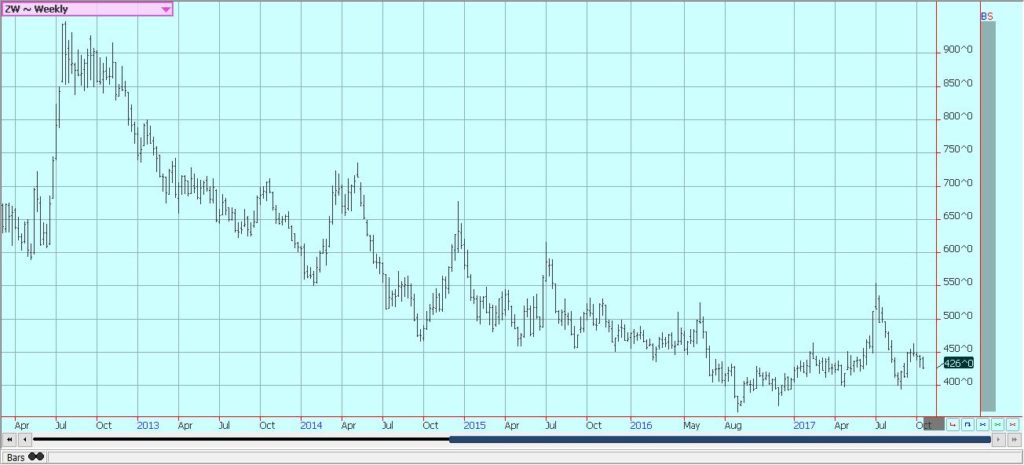
Weekly Chicago Soft Red Winter Wheat Futures © Jack Scoville
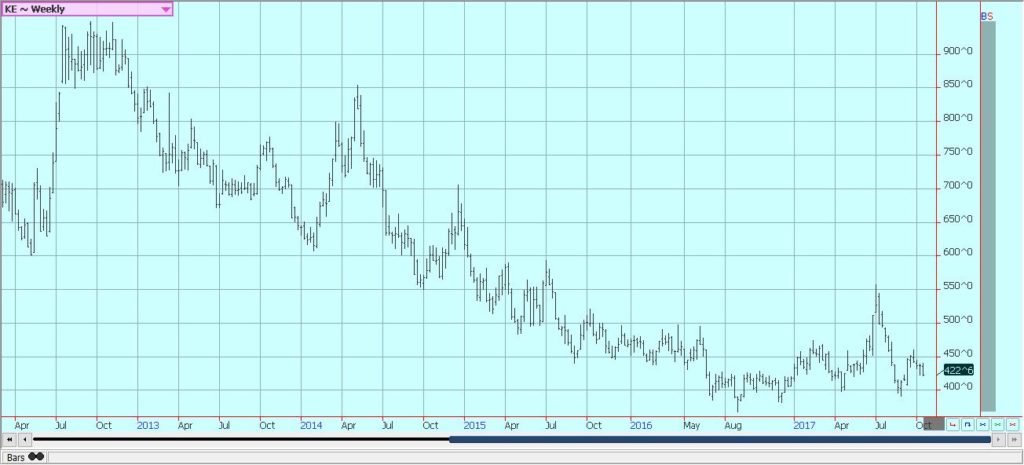
Weekly Chicago Hard Red Winter Wheat Futures © Jack Scoville
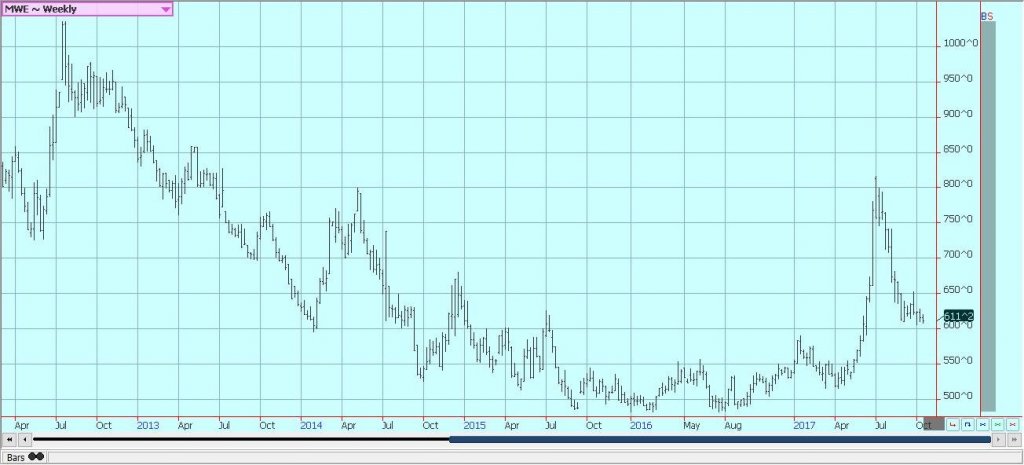
Weekly Minneapolis Hard Red Spring Wheat Futures © Jack Scoville
Corn
Corn closed lower and oats closed a little higher for the week as the US corn harvest expands in much of the Midwest. The export sales report on Thursday was very strong for corn and was a reason to buy the market, but traders seem much more interested in the harvest and the potential for increasing supplies. Basis levels remain very weak but are starting to improve again as transportation logistics become easier. The Mississippi and Illinois rivers have been low due to lack of rainfall and barge transportation has been difficult and very expensive.
There has been some significant rain in the Midwest over the last couple of weeks, with more seen over the weekend, and river levels should be improving. A lock on the Ohio River was closed for emergency repairs and that caused transportation problems on that river system, but has now been repaired. Basis levels throughout the Midwest have reacted to the improved situation, although they remain generally weak as it is still harvesting time.
The market is hearing more harvest results as activity moves north into central parts of the Corn Belt and also gets active in the east. Yields have been generally strong, but the harvest pace has been a little slow as producers have been concentrating more on getting the soybeans harvested and letting the corn dry in the fields. Many producers in central and eastern areas are now about done with the soybeans harvest and will now concentrate on corn.
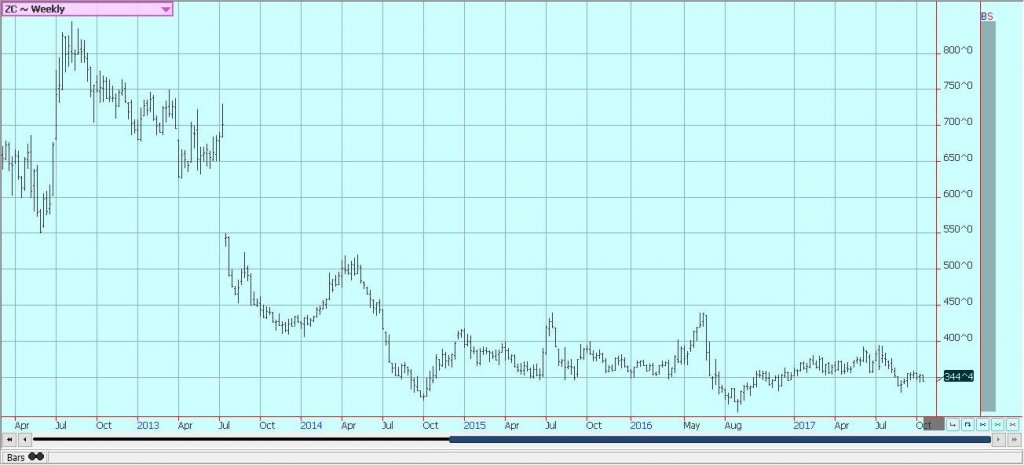
Weekly Corn Futures © Jack Scoville
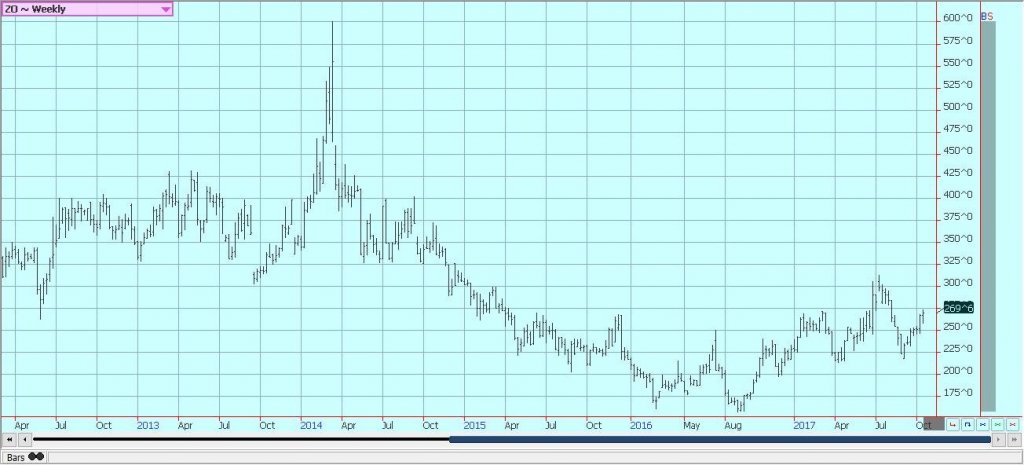
Weekly Oats Futures © Jack Scoville
Soybeans and Soybean Meal
Soybeans and soybean meal were lower on Friday in reaction to ideas of strong harvest progress and big crops being harvested. Soybean Meal also suffers from weak demand due to strong competition from DDGS in the market and on ideas that crush levels can remain strong due to the need to produce soybean oil on reduced Argentine imports. The US government moved to impose punitive duties on Argentine soybean oil imports into the US recently, then has tried to move mandate levels to reflect the reduced feedstock supply. The latter move has failed as the government said Friday that mandate levels will be maintained or expanded and not cut back in any way.
Harvest weather should be good this week in the Midwest after weekend rains as forecasts call for cool and dry conditions. There are still forecasts around for weather patterns to change in Brazil and bring some badly needed rain to the north and drier conditions to the south and into Argentina. The US harvest has been more active in areas east of the Mississippi River and is starting to finish in these areas, while areas to the west of the river are expanding.
The yield data generally runs behind year-ago levels, but are still very strong overall. Basis levels have started to improve as the river levels move higher due to recent rains, although basis levels have been weak in the Gulf of Mexico. It remains too dry for best planting in the northern half of Brazil, while the southern half of Brazil and the northern half of Argentina get too much rain. It is planting time for Soybeans there, but progress is very slow right now. Ideas are that the weather patterns there can start to change and more favorable planting weather will be seen near the end of the month.
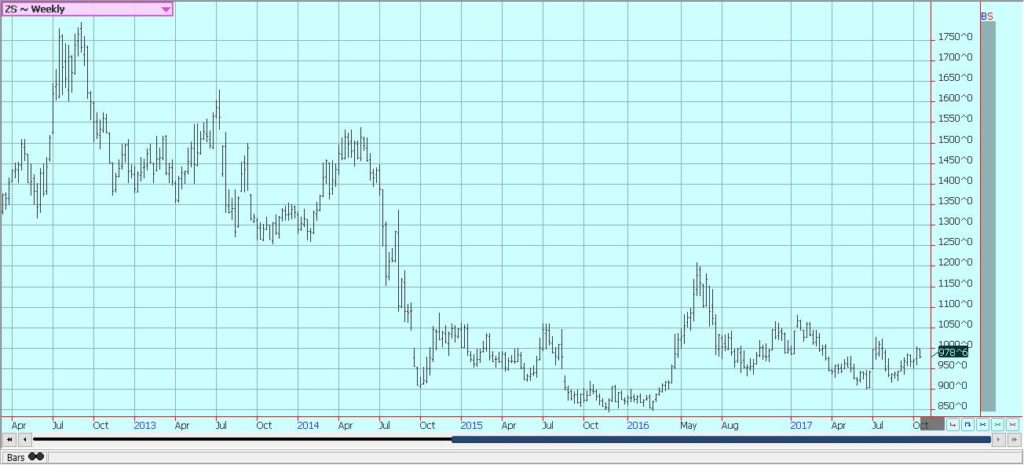
Weekly Chicago Soybeans Futures © Jack Scoville
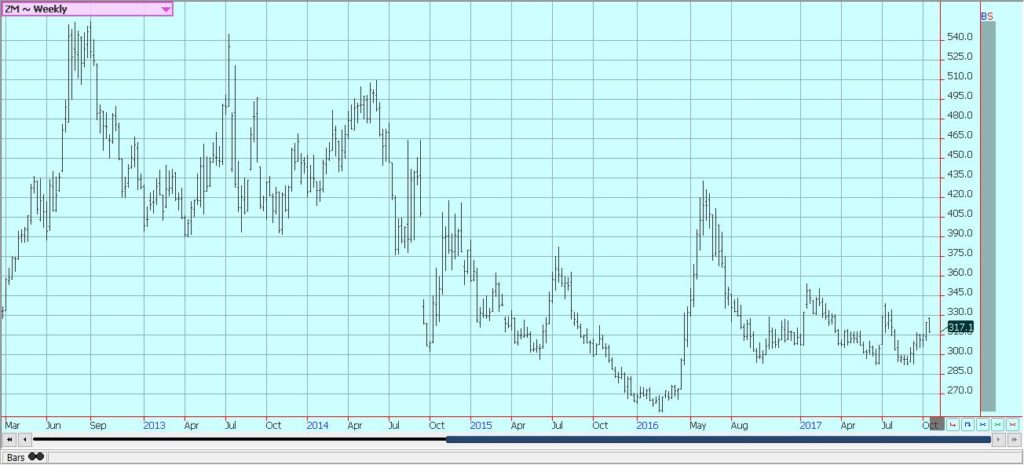
Weekly Chicago Soybean Meal Futures © Jack Scoville
Rice
Rice closed higher on Friday, but lower for the week. The daily charts still show futures prices locked in a short-term trading range. The sales report last week was strong and were especially strong for long grain into Latin America. That demand news has been great for the market. Latin American buyers in recent years have complained about the quality of the US crop and have bought more and more from Brazil or elsewhere in Latin America. The strong sales now show that the US quality is very good this year and also that the US is featuring competitive prices into these regions.
Domestic cash market conditions are generally quiet. The Delta harvest is about over and as farmers are holding out for higher prices. California has significant harvest progress to make now. Reports from the country indicate good to very good yields and quality for the Delta as the harvest comes to a close in most areas. Yields in California right now are lower than hoped for as the late start to planting appears to have created a short season and less yield potential. Domestic cash quotes have held generally steady amid little interest in the Delta and are called firm in California.

Weekly Chicago Rice Futures © Jack Scoville
Palm Oil and Vegetable Oils
Palm oil futures moved a little higher last week, and weekly charts show that the market remains in a trading range. The market moved higher as data released by the private sources showed that exports for the first half of the month were very strong. Both showed that exports this month are at least 10% higher than last month. China is back and buying now and demand could get stronger.
Canola was higher on a weaker Canadian dollar and despite increased farm selling and active harvest activity. Farmers have started to more actively sell and deliver as the harvest starts to move into its final stages. Yield reports yet imply a good but not great crop in just about all areas of the Prairies.
Soybean oil was also higher. The US government moved to impose punitive duties on Argentine soybean oil imports into the US recently, then has tried to move mandate levels to reflect the reduced feedstock supply. The latter move has failed as the government said Friday that mandate levels will be maintained or expanded and not cut back in any way. Ideas are that US domestic soybean oil demand can stay strong.
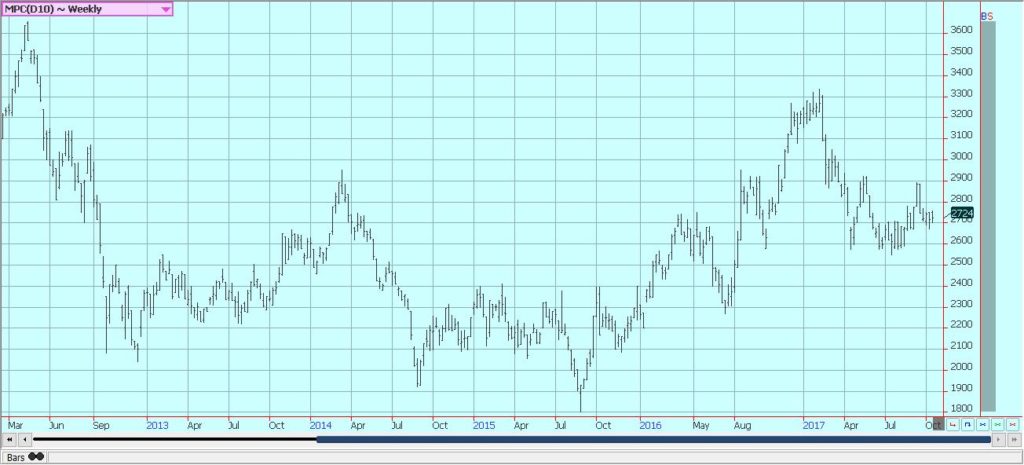
Weekly Malaysian Palm Oil Futures © Jack Scoville
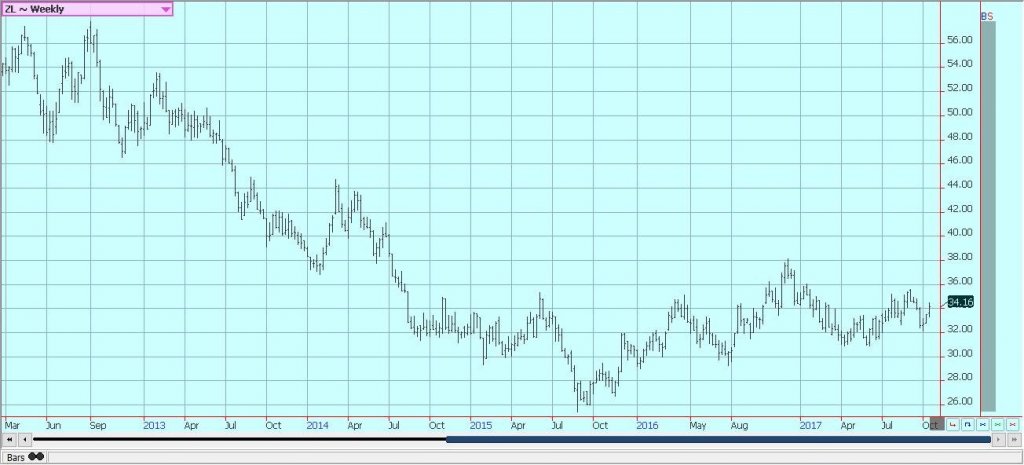
Weekly Chicago Soybean Oil Futures © Jack Scoville
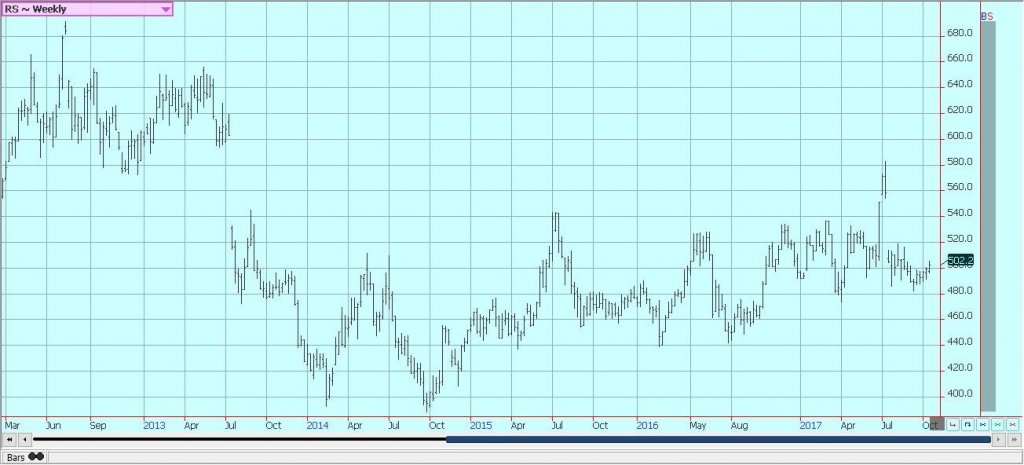
Weekly Canola Futures © Jack Scoville
Cotton
Cotton was lower last week as a big crop of good quality is being harvested. Even improved export sales could not support the market last week as the amount sold was not exceptional for this time of year at under 400,000 bales. The classing report released on Friday shows that quality is holding after the hurricanes seen in Texas and the Southeast this summer. The harvest still has a long way to go, but the quality is good and there is a lot of cotton that will have to come to the market sooner or later. Futures appear to be turning trends down again, and tests of 6500 December and perhaps near 6000 December are possible now.
Harvest is more active and will continue to expand as more and more of the crop comes to maturity. Bolls are opening now in just about all production areas, but harvest remains a little behind normal. West Texas conditions are called good and the Southwest should be good despite hot weather this year. There is strong production potential in Asia, and mostly in India and Pakistan due to improved monsoon rains. However, the rains were variable, with some areas getting flooding rains and others, not enough rain. Some rains are expected in most areas this week amid relatively moderate temperatures. Chinese growing conditions are good. Areas in southern Russia and surrounding nations are in good condition.

Weekly US Cotton Futures © Jack Scoville
Frozen Concentrated Orange Juice and Citrus
FCOJ closed higher and appear to be developing a trading range. The market has not been able to fill a gap left in reaction to Irma and the losses seen in Florida as a result of the devastating storm. Futures are still reacting to the USDA reports that showed big production loss potential from the hurricane, but not the losses expected by the trade. USDA is expected by many to show further dramatic cuts in production in coming reports.
Ideas remain that the orange groves are badly damaged in Florida due to Irma. Crops in many areas were almost completely destroyed. Other areas suffered losses of 50% or more of the crop. Some growers say that trees will be stressed again next year due to the winds and rains from Irma. The demand side remains weak and there are plenty of supplies in the US. Trees that are still alive now are showing fruits of good sizes, although many have lost a lot of the fruit. Brazil crops are stressed from the hot and dry weather.
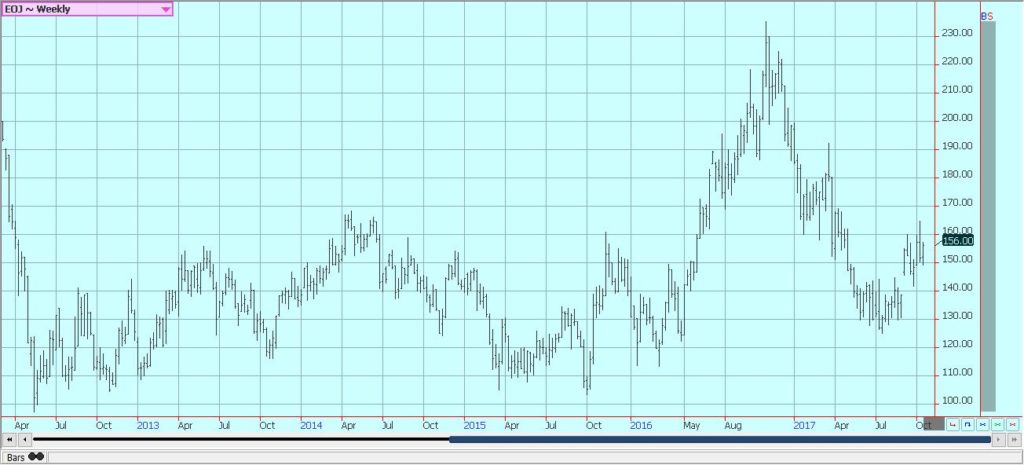
Weekly FCOJ Futures © Jack Scoville
Coffee
Futures were lower in New York and in London last week, with commercials scale down buyers and speculators still the best sellers, but now on both sides of the market. The trends are down on the charts in New York as traders look at the potential for a big crop in Brazil. London trends are sideways. The Brazil weather and tree condition is the main fundamental reason for lower New York prices but could become the major reason to buy the market soon.
Rains appeared in Brazil a couple of weeks ago, then it turned dry again. These rains promoted flowering, and some reports indicate that flowering has been very good. Other areas have seen good flowering but might not see much fruit as the trees have defoliated due to earlier stress. The current dry period is causing some to wonder if the flowers will start to abort.
There are some forecasts for rains early this week, but amounts and coverage forecasts have faded as the event draws closer. The rains will need to continue and be in good amounts as it has been very dry and trees have been stressed for a ear or more in some cases. Some were stressed after the production last year, while others suffered due to the dry and cold winter. Even so, improved weather now could mean a very good crop, although most likely not a huge crop of over 50 million bags.
Cash market conditions in Central America are more active as the next harvest continues. There is coffee to sell and offers are on the table for the next crop. Differentials have been stable but weak in the region. Colombia has reported some difficult growing conditions, but exports have held well as production appears to be good. Differentials have been stable and relatively strong.
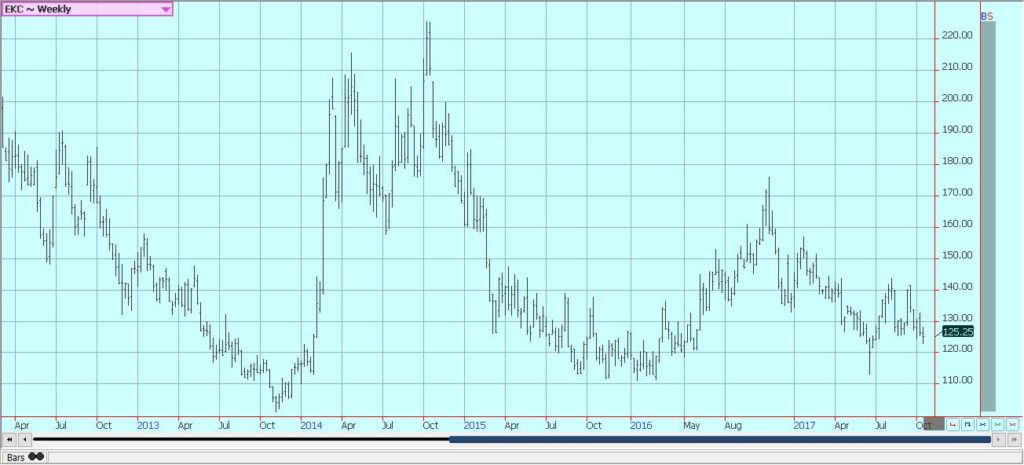
Weekly New York Arabica Coffee Futures © Jack Scoville
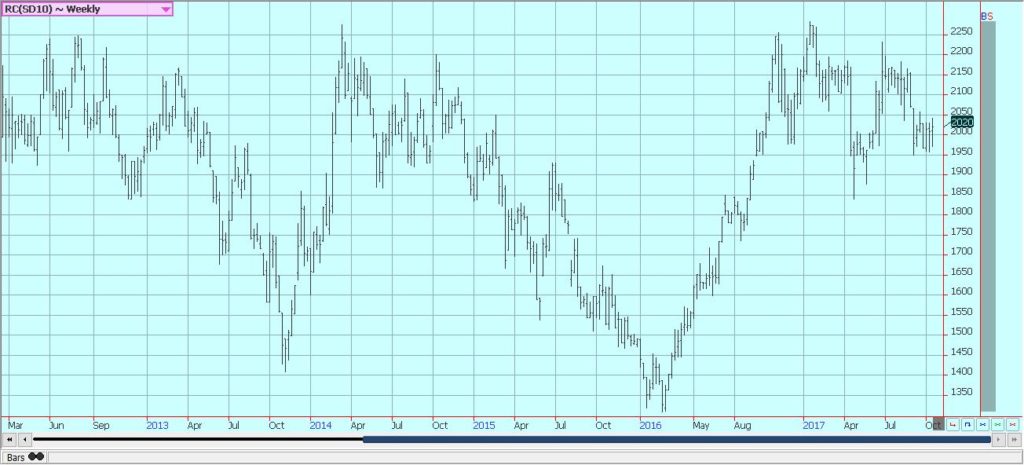
Weekly London Robusta Coffee Futures © Jack Scoville
Sugar
Futures were a little lower in New York and in London, and price trends remain sideways in both markets. Both markets held support areas on the weekly charts, but remain locked in sideways trends as ideas of big production go against hopes for improved demand. Brazil has been hot and dry, but some rains are in the forecast for early this week. No one is talking about production losses yet, but many are watching the situation. The market expects firmer prices over time as the Indian harvest could be delayed due to wet conditions that would delay sugarcane harvesting.
There are questions about the Indian production this year as the distribution on monsoon rains was not uniform. Some areas saw flooding rains while others got well below normal totals. The monsoon is starting to recede now. Overall upside potential is limited as there are still projections for a surplus in the world production, and these projections for the surplus seem to be getting bigger over time. Production potential in Thailand seems strong as monsoon rains have been better than last year. However, buying from the Far East has often gone to India lately as Thai differentials have been high.
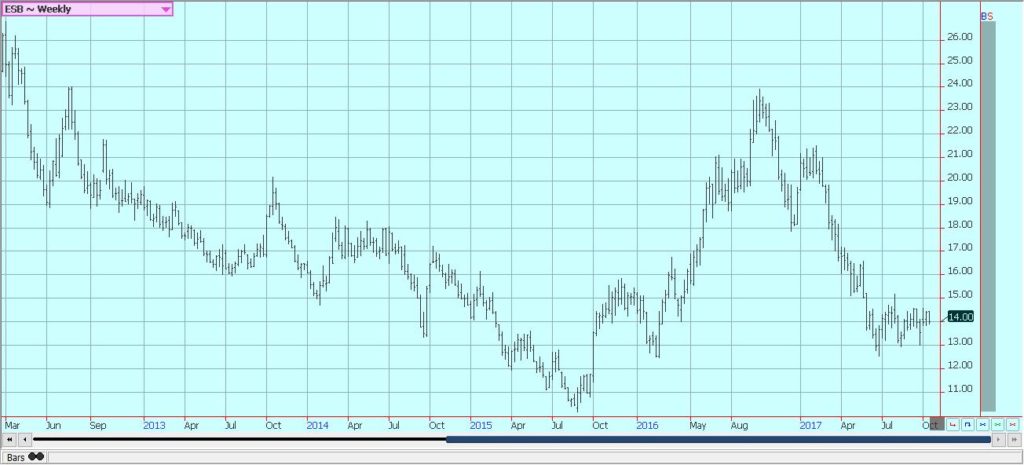
Weekly New York World Raw Sugar Futures © Jack Scoville
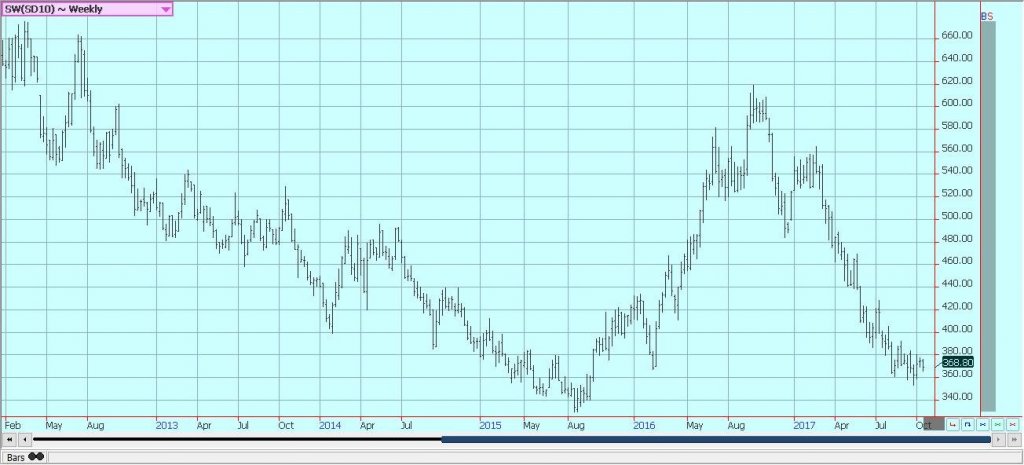
Weekly London White Sugar Futures © Jack Scoville
Cocoa
Futures closed a Little lower on Friday, but higher for the week in response to positive demand news from as the North American grind data last week and the European grind data the previous week. The North American data did show an increase in demand, but not as much as some traders had hoped for. The trends are now up in New York and in London on both the daily and weekly charts, although the weekly charts show that some important resistance is just ahead at about 2180 New York December.
Traders saw positive grind data from Asia on Friday. World production ideas remain high. Harvest reports show that good to very good production will be seen this year in West Africa. Ghana and Ivory Coast expects a very good crop this year. Nigeria and Cameroon are reporting good yields on the initial harvest, and also good quality. The growing conditions in other parts of the world are generally good. East Africa is getting better rains now. Good conditions are still seen in Southeast Asia. Traders talk of increased demand to go against big world production as prices are now attractive for grinders and chocolate manufacturers.

Weekly New York Cocoa Futures © Jack Scoville
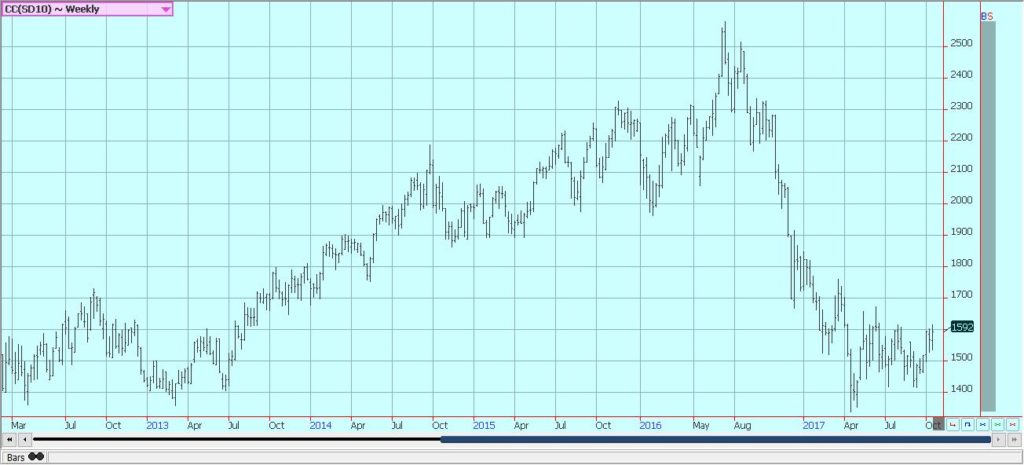
Weekly London Cocoa Futures © Jack Scoville
Dairy and Meat
Dairy markets were sharply lower again last week and Milk futures made new lows for the move. The Global Dairy Auction was weaker last week. USDA reports ample supplies, but good to very good demand in just about all parts of the US. Milk and cheese demand has been mixed, but Butter demand has weakened and prices in this market have moved sharply lower. Demand is good for cream, but cream has generally been available to meet the demand.
Cream demand for butter has been very good. Demand for ice cream has been mixed depending on the region but is holding well due to mild weather in much of the US. Cheese demand still appears to be weaker and inventories appear high. US production conditions have featured some abnormally hot weather in the west that is hurting milk production. Production in the rest of the country has been strong.
US cattle and beef prices were lower, but futures held up trends. Beef prices remain firm, and cattle traded about #2.00 per hundredweight higher last week. Ideas are that packers are still enjoying very strong margins at this time and can afford to pay more for cattle. This did happen last week. The beef market was somewhat better last week to support ideas that prices for cattle could continue to improve.
Cattle prices were steady to slightly weaker in early dealings and amid lighter than expected volume. It is the threat of increased supplies down the road that keeps the packers from buying aggressively. Feedlots are full, but ideas are that the big offer of cattle has passed. The monthly cattle on feed report on Friday showed big placements, so prices should move lower this week in both live cattle and feeder cattle futures.
Pork markets and lean hogs futures were higher. Ideas are that futures are reflecting the weaker supply and demand fundamentals now, but the overall market seems to be improving. Demand has been improved for the last couple of weeks and this has affected pricing. There are still ideas of bug supplies out there, but the market seems to have the supply side priced. The weekly charts show that the market is trying to form a low at current prices, and futures have been cheap enough that a low is possible at this time. The weekly charts suggest that futures are completing an important bottom in prices at this time.

Weekly Chicago Class 3 Milk Futures © Jack Scoville
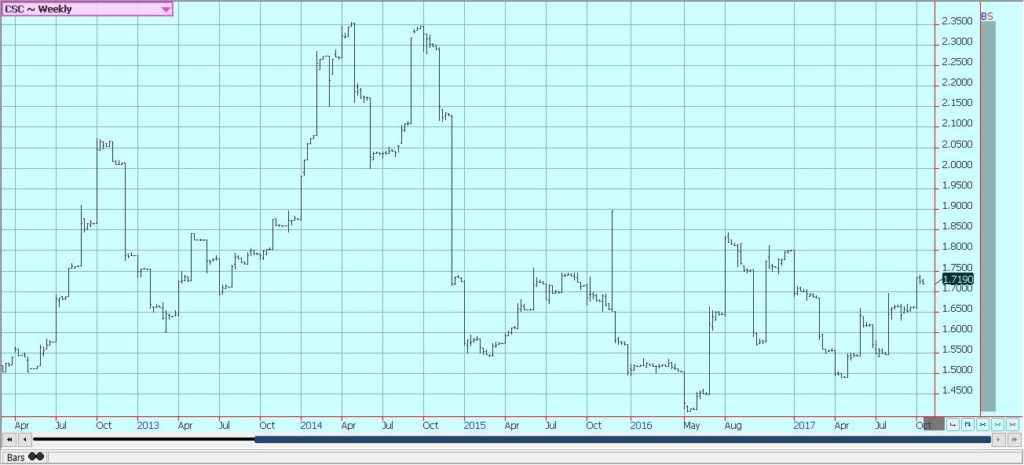
Weekly Chicago Cheese Futures © Jack Scoville

Weekly Chicago Butter Futures © Jack Scoville

Weekly Chicago Live Cattle Futures © Jack Scoville
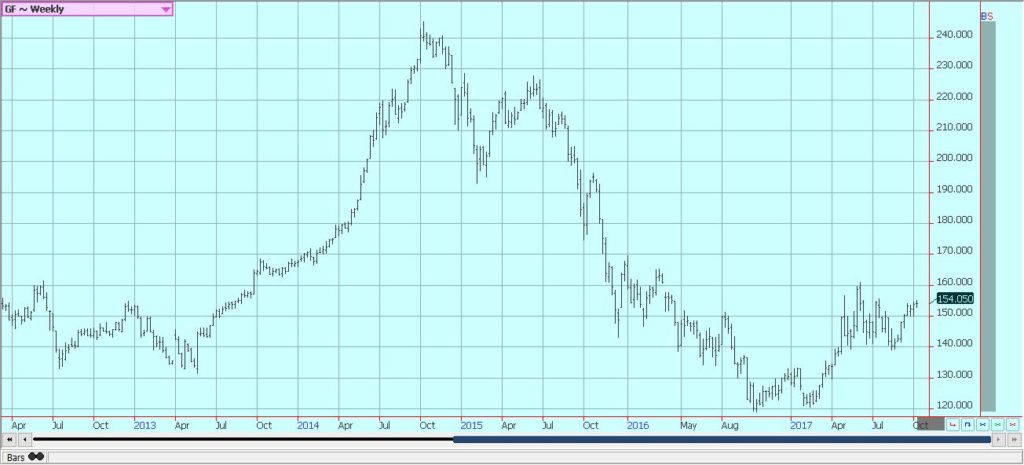
Weekly Feeder Cattle Futures © Jack Scoville
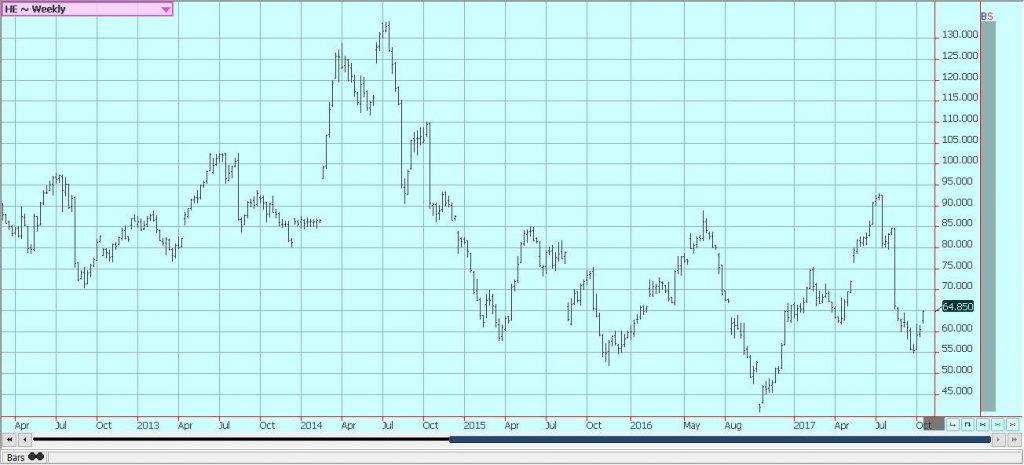
Weekly Chicago Lean Hog Futures © Jack Scoville
—
DISCLAIMER: This article expresses my own ideas and opinions. Any information I have shared are from sources that I believe to be reliable and accurate. I did not receive any financial compensation in writing this post, nor do I own any shares in any company I’ve mentioned. I encourage any reader to do their own diligent research first before making any investment decisions.
(Featured image by United Soybean Board via Wikimedia Commons. CC BY 2.0)

-

 Cannabis7 days ago
Cannabis7 days agoRecord-Breaking Mary Jane Fair in Berlin Highlights Cannabis Boom Amid Political Uncertainty
-

 Impact Investing2 weeks ago
Impact Investing2 weeks agoGlobal Gender Gap Progress Slows Amid Persistent Inequality and Emerging Risks
-

 Biotech4 days ago
Biotech4 days agoVytrus Biotech Marks Historic 2024 with Sustainability Milestones and 35% Revenue Growth
-

 Crowdfunding2 weeks ago
Crowdfunding2 weeks agoColombia Approves Terrenta’s Crowdfunding Platform for Real Estate Financing








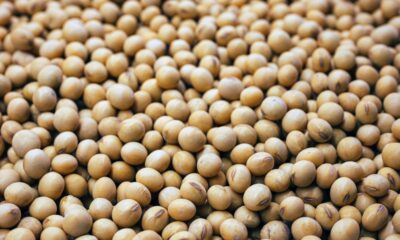

















You must be logged in to post a comment Login